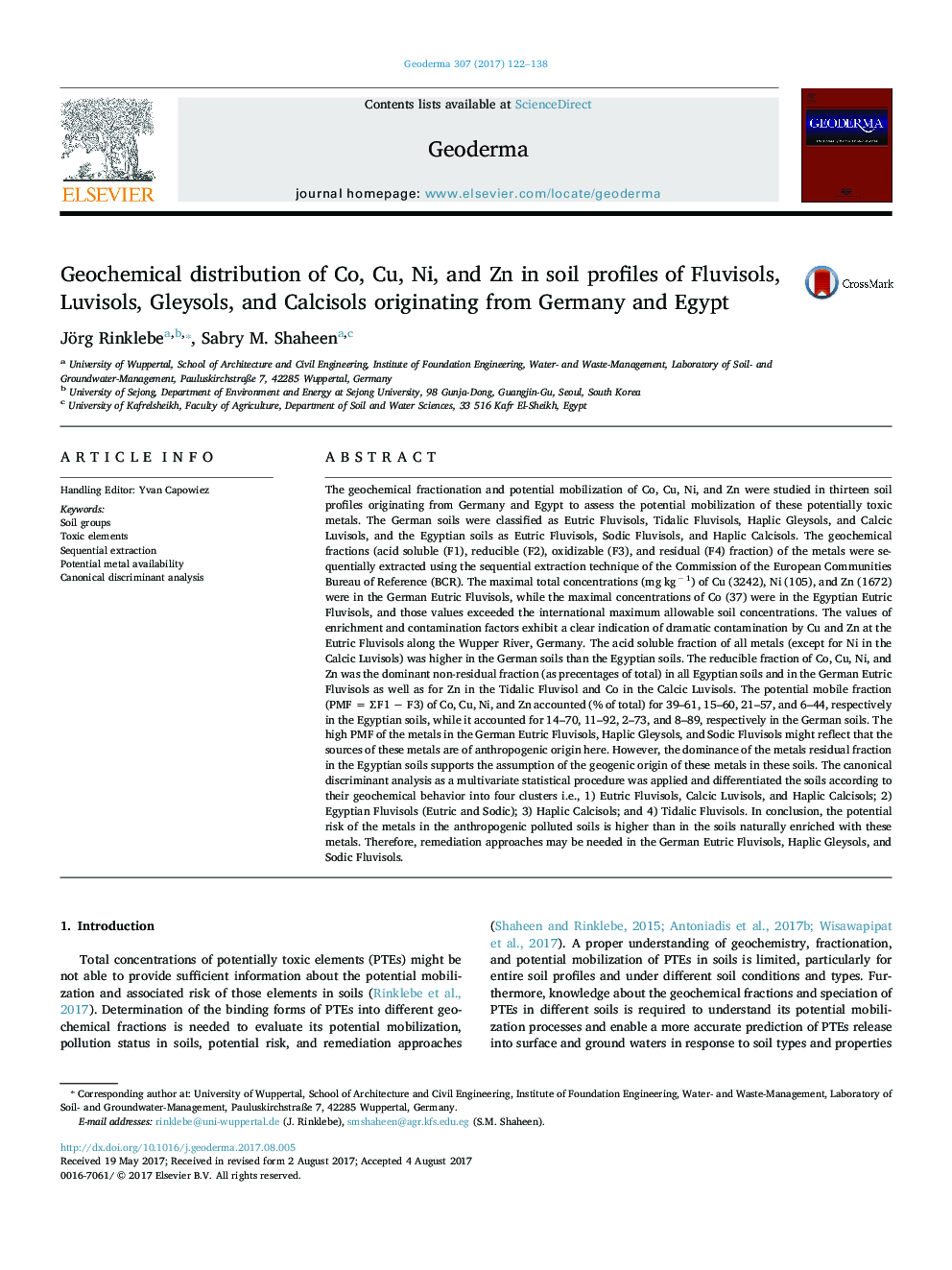| کد مقاله | کد نشریه | سال انتشار | مقاله انگلیسی | نسخه تمام متن |
|---|---|---|---|---|
| 5770237 | 1629410 | 2017 | 17 صفحه PDF | دانلود رایگان |

- The metals acid soluble fraction was higher in the German than the Egyptian soils.
- The residual fraction of all metals was dominant in the Egyptian soils.
- The metals potential mobility (PM) was higher in the German than the Egyptian soils.
- Cobalt showed the highest PM in the Egyptian soils and Cu in the German soils.
- Individual soil profiles can be discriminated via Canonical Discriminant Analysis.
The geochemical fractionation and potential mobilization of Co, Cu, Ni, and Zn were studied in thirteen soil profiles originating from Germany and Egypt to assess the potential mobilization of these potentially toxic metals. The German soils were classified as Eutric Fluvisols, Tidalic Fluvisols, Haplic Gleysols, and Calcic Luvisols, and the Egyptian soils as Eutric Fluvisols, Sodic Fluvisols, and Haplic Calcisols. The geochemical fractions (acid soluble (F1), reducible (F2), oxidizable (F3), and residual (F4) fraction) of the metals were sequentially extracted using the sequential extraction technique of the Commission of the European Communities Bureau of Reference (BCR). The maximal total concentrations (mg kgâ 1) of Cu (3242), Ni (105), and Zn (1672) were in the German Eutric Fluvisols, while the maximal concentrations of Co (37) were in the Egyptian Eutric Fluvisols, and those values exceeded the international maximum allowable soil concentrations. The values of enrichment and contamination factors exhibit a clear indication of dramatic contamination by Cu and Zn at the Eutric Fluvisols along the Wupper River, Germany. The acid soluble fraction of all metals (except for Ni in the Calcic Luvisols) was higher in the German soils than the Egyptian soils. The reducible fraction of Co, Cu, Ni, and Zn was the dominant non-residual fraction (as precentages of total) in all Egyptian soils and in the German Eutric Fluvisols as well as for Zn in the Tidalic Fluvisol and Co in the Calcic Luvisols. The potential mobile fraction (PMF = â F1 â F3) of Co, Cu, Ni, and Zn accounted (% of total) for 39-61, 15-60, 21-57, and 6-44, respectively in the Egyptian soils, while it accounted for 14-70, 11-92, 2-73, and 8-89, respectively in the German soils. The high PMF of the metals in the German Eutric Fluvisols, Haplic Gleysols, and Sodic Fluvisols might reflect that the sources of these metals are of anthropogenic origin here. However, the dominance of the metals residual fraction in the Egyptian soils supports the assumption of the geogenic origin of these metals in these soils. The canonical discriminant analysis as a multivariate statistical procedure was applied and differentiated the soils according to their geochemical behavior into four clusters i.e., 1) Eutric Fluvisols, Calcic Luvisols, and Haplic Calcisols; 2) Egyptian Fluvisols (Eutric and Sodic); 3) Haplic Calcisols; and 4) Tidalic Fluvisols. In conclusion, the potential risk of the metals in the anthropogenic polluted soils is higher than in the soils naturally enriched with these metals. Therefore, remediation approaches may be needed in the German Eutric Fluvisols, Haplic Gleysols, and Sodic Fluvisols.
Journal: Geoderma - Volume 307, 1 December 2017, Pages 122-138